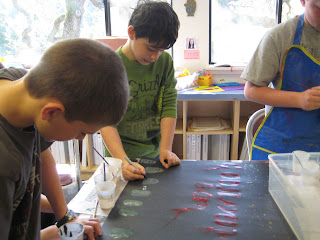Our Edot class has been preparing over the past few sessions for our upcoming Crypto-Jewish Seder, scheduled for this coming Saturday evening. We have learned the history of the Jews of Spain, with particular emphasis on the period following the 1492 unification of the Christian states of Spain by King Ferdinand and Queen Isabella, when Jews were forced to leave the country or convert to Catholicism. Scholars believe that approximately a quarter of a million Jews left Spain at that time, and that as many and perhaps even more stayed in Spain, unwilling to give up the country they had called home for over a thousand years by that time. Of those Jews who converted, many became true Christians, but many could not give up the religion of their ancestors, and secretly continued to practice Judaism, very often on pain of torture and ultimate death. These "Crypto-Jews," as we refer to them in English (they called themselves "conversos" and the Spanish authorities referred to them as "marranoes," meaning "swine" in 15th century Spanish) lived in constant fear, always wondering if a servant, neighbor, or friend, or even family member who had been arrested and tortured, might give them away. They prayed by running rivers, in caves, or in underground chambers, usually at night. During the day, they had to go to mass, and celebrate all Catholic holidays. Without benefit of rabbis, synagogues, Jewish calendars, Jewish prayer books and other religious texts, they began to confuse the Christian and Jewish rituals and prayers, and, over several generations, forgot most of them.
There was one holiday which they never forgot - the Passover. This is the time when Jews have always retold the Exodus story, when we were slaves in Egypt and then led to freedom, ultimately reaching the Promised Land. For the Crypto-Jews, slavery was real - they had no control over their lives; freedom was still a dream, of the time they could return to the Land of Israel, or perhaps even remain in Spain and be allowed to live openly, without fear, as Jews. They held Passover seders (the ritual meal of Passover, during which time the Exodus story is retold) in secret places. They forgot many of the seder rituals, and instituted their own. Thankfully, they never forgot the Exodus story itself since the Catholic Bible includes the Hebrew Bible. The Exodus story is told in the Book of Exodus, the second of the first five books of the Hebrew Bible, referred to in Hebrew as the Torah.
King Ferdinand and Queen Isabella invited the Office of the Inquisition to begin operations in Spain in 1481. It was the mission of the Holy Tribunal of the Inquisition, first established by the Catholic Church in the 12th century, to root out all heretics. In Spain, the focus was on the Jews, and, following 1492, on the "Crypto-Jews". The Inquisition had its own army and network of spies, who studied Jewish belief and ritual in order to help identify secret Jews. Passover was a very busy time for them as they searched for evidence of seder rituals in homes (matza, koshered meat, etc.). They were also known to raid seder ceremonies. During the trials of accused Crypto-Jews, detailed notes were taken by the Inquisition, and it is from these notes that we learn about details relating to the Crypto-Jewish seder ceremonies such as the new rituals created by Crypto-Jews to replace those they had forgotten, and even recipes they used for their seder meals.
Our Edot class Crypto-Jewish seder will be a "living reenactment" of one such seder ceremony, using the information garnered from Inquisition records. Our meal will consist of roasted lamb, chickpeas in honey and cilantro, haroset balls, and huevos haminados, along with fresh and dried fruits. In preparation for the seder, each of our Edot students has been assembling a "Crypto-Jewish Haggadah," which includes symbolic drawings representing the parts of the seder ceremony, the blessings for the seder plate foods, and paragraphs they have written, imagining how they feel as Crypto-Jews living in Saragossa, Spain in the year 1591. The Haggadot will also include the "Dayeinu" song, which is a summary of the major events of the Exodus story, the "Adon Olam" song, which praises God and which the Crypto-Jews sang directly after the seder meal, adding their own praising words to God after they had forgotten the original words, and the Ladino version of "Chad Gadya" ("Un Cavritico"), the last song in the Passover Haggadah, which assures Israel that God will destroy all its enemies. This last song was especially important to the Crypto-Jews, who dreamed of being redeemed by God.
The students also painted "Dayeinu" song posters (one poster for each verse of the song), which we will use during our seder on Saturday evening, pointing out the illustration for each verse as we sing it. As always, the students rolled up their sleeves and worked together to create amazing art work. I am always so impressed with the results, given the very little time we have in Religious School. Bravo to our Edot artists.
Stay tuned next week for my blog about our Crypto-Jewish Seder!









No comments:
Post a Comment